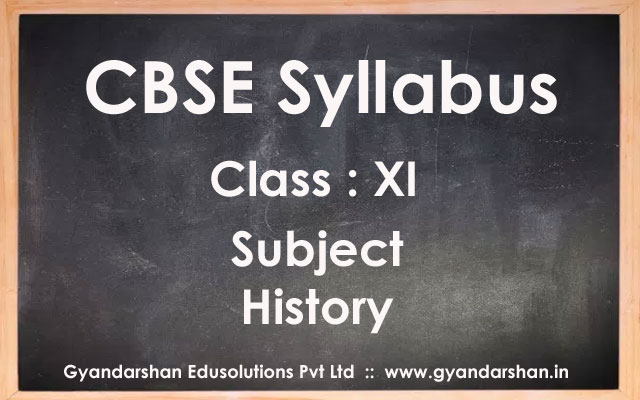
History Class XI Syllabus
Exam Structure
| S.No. | Units | Marks |
| 1. | Introduction to World History | |
| Section A: Early Societies | 15 | |
| 2. | Introduction | |
| 3. | From the beginning of time | |
| 4. | Early Cities | |
| Section B: Empires | 20 | |
| 5. | Introduction | |
| 6. | An empire across three continents | |
| 7. | Central Islamic lands | |
| 8. | Nomadic Empires | |
| Section C: Changing Traditions | 20 | |
| 9. | Introduction | |
| 10. | Three orders | |
| 11. | Changing cultural traditions | |
| 12. | Confrontation of cultures | |
| Section D: Paths to Modernization | 20 | |
| 13. | Introduction | |
| 14. | The Industrial Revolution | |
| 15. | Displacing indigenous People | |
| 16. | Paths to modernization | |
| Map work (units 1-16) | 5 | |
| Project Work | 20 | |
| Total | 100 | |
1. Introduction to World History
Section A: Early Societies
2. Introduction
3. From the Beginning of Time
Focus: Africa, Europe till 15000 BC
- Views on the origin of human beings.
- Early societies.
- Historians’ views on present-day hunting-gathering societies.
4. Early Cities
Focus: Iraq, 3rd millennium BC
- Growth of towns.
- Nature of early urban societies.
- Historians’ Debate on uses of writing.
Section B: Empires
5. Introduction
6. An Empire across Three Continents
Focus: Roman Empire, 27 B.C to A.D 600.
- Political evolution
- Economic expansion
- Religion
- Late Antiquity
- Historians’ views on the institution of Slavery
7. Central Islamic Lands
Focus: 7th to 12th centuries
- Polity
- Economy
- Culture
- Historians’ viewpoints on the nature of the crusades
8. Nomadic Empires
Focus: the Mongol, 13th to 14th century
- The nature of nomadism
- Formation of empires
- Conquests and relations with other states
- Historians’ views on nomadic societies and state formation
Section C: Changing Traditions
9. Introduction
10. Three Orders
Focus: Western Europe, 13th-16th century
- Feudal society and economy
- Formation of states
- Church and Society
- Historians’ views on decline of feudalism
11. Changing Cultural Traditions
Focus on Europe, 14th to 17th century.
- New ideas, and new trends in literature and arts.
- Relationship with earlier ideas
- The contribution of West Asia.
- Historians’ viewpoints on the validity of the notion ‘European Renaissance’.
12. Confrontation of Cultures
Focus on America, 15th to 18th century.
- European voyages of exploration.
- Search for gold; enslavement, raids, extermination.
- Indigenous people and cultures – the Arawaks, the Aztecs, the Incas.
- The history of displacements.
- Historians’ viewpoints on the slave trade.
Section D: Paths to Modernization
13. Introduction
14. The Industrial Revolution
Focus on England, 18th and 19th century.
- Innovations and technological change
- Patterns of growth.
- Emergence of a working class.
- Historians’ viewpoints, Debate on ‘Was there an Industrial Revolution?’
15. Displacing Indigenous People
Focus on North America and Australia, 18th-20th century.
- European colonists in North America and Australia.
- Formation of white settler societies.
- Displacement and repression of local people.
- Historians’ viewpoints on the impact of European settlement on indigenous population.
16. Paths to Modernization
Focus on East Asia, late 19th and 20th century.
- Militarization and economic growth in Japan.
- China and the Communist alternative.
- Historians’ Debate on the meaning of modernization
17. Map Work on Units 1-16













